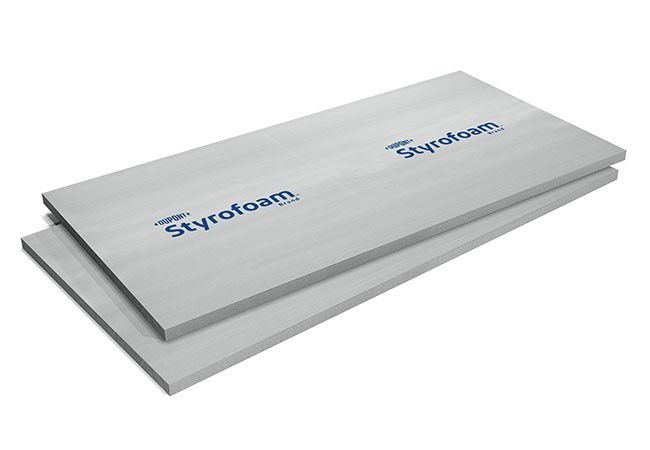DuPont™ Styrofoam™ Brand Panel Core 20 Freezer XPS Insulation
High Performance Insulation for Walk-In Coolers and Freezers<br>U.S. HFC Regulation Compliant Formulation

DuPont™ Styrofoam™ Brand Panel Core 20 Freezer XPS Insulation
High Performance Insulation for Walk-In Coolers and Freezers<br>U.S. HFC Regulation Compliant Formulation
Features & Benefits
Specifications
Testing
<b>Styrofoam™ Brand Panel Core 20 Freezer XPS Insulation</b> exhibits the properties and characteristics indicated in the table below when tested as represented. Review all instructions and (Material) Safety Data Sheet ((M)SDS) before use. Please contact DuPont at 1-833-338-7668 when additional guidance is required for writing specifications that include this product.
| TEST METHOD | TEST TITLE | PROPERTY | RESULTS |
|---|---|---|---|
| FIRE | |||
| UL 723 | Test Method for Surface Burning Characteristics of Building Materials | Surface Burning Characteristics | Flame Spread ≤ 25 Smoke Developed ≤ 450 |
| THERMAL | |||
| ASTM C518 | Standard Test Method for Steady-State Thermal Transmission Properties by Means of the Heat Flow Meter Apparatus | Thermal Resistance per inch: fresh @ 55 °F (13° C) min. fresh @ 20 °F (-7 °C) min.1 | 7.2 ft2•h•°F/Btu, R-value, min. 8.0 ft2•h•°F/Btu, R-value, min. |
| ASTM D696 | Standard Test Method for Coefficient of Linear Thermal Expansion of Plastics Between −30°C and + 30°C with a Vitreous Silica Dilatometer | Coefficient of Linear Thermal Expansion | 3.5 x 10-5 in/in•°F |
| ASTM D2126 | Standard Test Method for Response of Rigid Cellular Plastics to Thermal and Humid Aging | Change in Dimensions | 2.0% change, max. |
| STRENGTH | |||
| ASTM D1621 | Standard Test Method for Compressive Properties of Rigid Cellular Plastics | Compressive Strength2 | 20 psi, min. |
| ASTM C203 | Standard Test Methods for Breaking Load and Flexural Properties of Block-Type Thermal Insulation | Flexural Strength | 40 psi, min., extruded |
| ASTM C203 | Standard Test Methods for Breaking Load and Flexural Properties of Block-Type Thermal Insulation | Flexural Modulus | 1,500 psi, min., extruded |
| ASTM D1623 | Standard Test Method for Tensile and Tensile Adhesion Properties of Rigid Cellular Plastics | Tensile Strength | 50 psi, min., vertical |
| ASTM C273 | Standard Test Method for Shear Properties of Sandwich Core Materials | Shear Strength | 25 psi, min. |
| ASTM C273 | Standard Test Method for Shear Properties of Sandwich Core Materials | Shear Modulus | 300 psi, min. |
| WATER | |||
| ASTM C272 | Standard Test Method for Water Absorption of Core Materials for Sandwich Construction | Water Absorption | 0.1% by volume, max. |
| ASTM E96 | Standard Test Methods for Gravimetric Determination of Water Vapor Transmission Rate of Materials | Water Vapor Permeance3 | 1.5 perm, max. |
1R means resistance to heat flow. The higher the R-value, the greater the insulating power.
2Vertical compressive strength is measured at 10 percent deformation or at yield, whichever occurs first. Since Styrofoam™ Brand Extruded Polystyrene Foam Insulations are visco-elastic materials, adequate design safety factors should be used to prevent long-term creep and fatigue deformation.
3Based on 1” thickness.
Code Compliance
<b>Styrofoam™ Brand Panel Core 20 Freezer XPS Insulation</b> complies with the following codes:
| Code | Description |
|---|---|
| US Product Listings & Verifications | Underwriters Laboratories, Inc. (UL) Classified, see Classification Certificate D-369 |
| Regional Code Listings & Reports | California Std. Reg. #CA T1535 |
